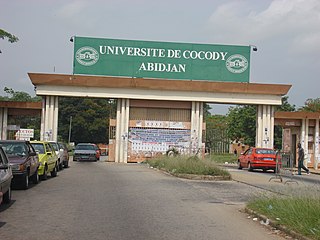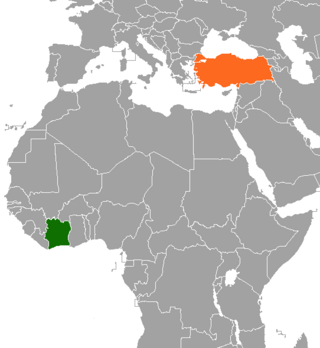Prior to 20th century
| History of Ivory Coast |
|---|
 |
- 1898 - Village of Abidjan founded. [1]
The following is a timeline of the history of the city of Abidjan, Ivory Coast.
| History of Ivory Coast |
|---|
 |

Yamoussoukro is the capital of Ivory Coast and an autonomous district. As of the 2014 census, Yamoussoukro is the fifth most populous city in the Ivory Coast, with a population of 212,670. Located 240 kilometers (150 mi) north-west of Abidjan, the district of Yamoussoukro covers 2,075 square kilometers (801 sq mi) among rolling hills and plains.

The Ivory Coast, also known as Côte d'Ivoire and officially the Republic of Côte d'Ivoire, is a country on the southern coast of West Africa. Its capital city of Yamoussoukro is located in the centre of the country, while its largest city and economic centre is the port city of Abidjan. It borders Guinea to the northwest, Liberia to the west, Mali to the northwest, Burkina Faso to the northeast, Ghana to the east, and the Atlantic Ocean's Gulf of Guinea to the south. With 31.5 million inhabitants in 2024, Ivory Coast is the third-most populous country in West Africa. Its official language is French, and indigenous languages are also widely used, including Bété, Baoulé, Dyula, Dan, Anyin, and Cebaara Senufo. In total, there are around 78 languages spoken in Ivory Coast. The country has a religiously diverse population, including numerous followers of Islam, Christianity, and traditional faiths often entailing animism.

Félix Houphouët-Boigny, affectionately called Papa Houphouët or Le Vieux, was an Ivorian politician and physician who served as the first president of Ivory Coast from 1960 until his death in 1993. A tribal chief, he worked as a medical aide, union leader, and planter before being elected to the French Parliament in 1945. He served in several ministerial positions within the Government of France before leading Ivory Coast following independence in 1960. Throughout his life, he played a significant role in politics and the decolonisation of Africa.

Cocody is a suburb of and one of the 10 urban communes of Abidjan, Ivory Coast. It is upmarket and has an abundance of mansions. Cocody is where most of the wealthy businesspeople, ambassadors, and other affluent people live in Abidjan. The Université Félix Houphouët-Boigny is located in Cocody.

Africa Sports d'Abidjan is a multi-sports club based in Abidjan, Ivory Coast.
The African Agricultural Union was the first quasi-political party in Côte d'Ivoire, led by Félix Houphouët-Boigny throughout its existence. It was established on 3 September 1944 by Houphouët-Boigny and the colonial administration.

Abidjan is the largest city and the former capital of Ivory Coast. As of the 2021 census, Abidjan's population was 6.3 million, which is 21.5 percent of the overall population of the country, making it the sixth most populous city proper in Africa, after Lagos, Cairo, Kinshasa, Dar es Salaam, and Johannesburg. A cultural crossroads of West Africa, Abidjan is characterised by a high level of industrialisation and urbanisation. It is also the most populous French-speaking city in Africa.

Félix-Houphouët-Boigny International Airport, also known as Port Bouët Airport, is located 16 km south east of Abidjan, Ivory Coast. It is the largest airport in the country for air traffic. The airport is the main hub of the national airline Air Côte d'Ivoire. Named after the first president of Ivory Coast, Félix Houphouët-Boigny, this international airport is directly connected currently to airports in Europe and to many destinations within the rest of Africa and the Middle East. The airport is served by 21 airlines, covering more than 30 destinations.

Port-Bouët is a suburb of Abidjan, Ivory Coast. It is one of the 10 urban communes of the city. Port-Bouët is one of four communes of Abidjan that are entirely south of Ébrié Lagoon, the others being Treichville, Koumassi, and Marcory.

Université Félix Houphouët-Boigny (UFHB) is an institution of higher education located in the Cocody section of Abidjan and the largest in Côte d'Ivoire. With over 50,000 students, the UFHB has 13 faculties and several research centers providing diplomas from two-year undergraduate to professional academic, medical, legal, and specialist degrees. From 1964 to 1996, it remained the main campus of the national University of Abidjan system. It is state owned and operated by the Ministry of Higher Education and Scientific Research. In 2008, it had 53,700 students.
The Autorité Nationale de l'Aviation Civile (ANAC) is the civil aviation authority of the Ivory Coast, subservient to the Ministry of Transport. Its head office is in Abidjan. It serves as the air accident investigation authority of the country. ANAC is a public institution with national competence and has technical and management autonomy. It was created by the Ivorian State by Law 0021/2005 of March 11, 2005. The Ivorian government announced the official launch of ANAC by Transport Minister Albert Mabri Toikeusse on October 30, 2008.

On December 4, 1958, Ivory Coast became a member state within the French Community. On August 7, 1960, Ivory Coast achieved its full independence from France, and Félix Houphouët-Boigny became the first president after the independence.

The Abidjan Metro is a 37.5-kilometre (23.3 mi) rapid transit network under construction serving the Ivorian economic capital of Abidjan. Construction of the network started in November 2017, with the beginning of passenger service originally expected in 2022–2023, but has since been delayed due to the COVID-19 pandemic to at least 2028. Initially planned to comprise a single line with 13 stations undertaken by Bouygues-Dongsan, a French-Korean consortium, the project has since then been expanded to a single north–south line with 20 stations, financed 100% by France and built solely by three French groups after the withdrawal of the South Korean partners from the consortium in October 2017.

The Autonomous Port of Abidjan is a commercial port at Treichville, in southern Abidjan, Ivory Coast. It is a transshipment and intermodal facility and is managed as a public industrial and commercial establishment; the Director-General is Hien Sié.

Anne Jacqueline Oble, also known as Jacqueline Lohoues-Oble, is an Ivorian lawyer and politician who was the first woman to stand as a candidate in a presidential election.

Ivory Coast–Turkey relations are the foreign relations between Ivory Coast and Turkey.

Denise Houphouët-Boigny is an Ivorian academic and diplomat currently serving as Cote d'Ivoire's ambassador to UNESCO. She is a Doctor of Science and professor of mineral chemistry. She is a member of the Academy of Sciences, Arts, Cultures of Africa and African Diasporas of Côte d'Ivoire.
National Pupils and Students Union of Ivory Coast, generally called UNEECI, was an organization of students and pupils in Ivory Coast.
This article incorporates information from the French Wikipedia and the German Wikipedia.
![]() Media related to History of Abidjan at Wikimedia Commons
Media related to History of Abidjan at Wikimedia Commons